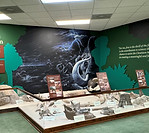Location
109 Central Ave,
Clewiston FL 33440

Prehistoric Creatures Who Walked or Swam Over This Land
The Clewiston Museum fossil collection represents creatures of the Glades from thousands and millions of years ago. The collection consists of fossils of mammoths, mastodons, giant ground sloths, megalodons, saber-tooth cats, a dugong, a giant land tortoise and many others.

Spanish Galleons & Treasures
Gold and treasure from South America has been found in the Glades! Histories and important details are highlighted in this exhibit.

Fish of Lake Okeechobee
Bass, catfish and other fish have been tremendous magnets for sport fishing as well as commercial fishing. The lake ecosystem which includes birds, alligators, and other fauna and flora, plays a huge part in the history of the Glades area.

Seminole & Miccosukee
Prior to the 20th century Native Americans (Caloosa, Seminole, Miccosukee) thrived in the Glades. The exhibits contain clothing, patchwork, tools, and adornments they used.

Historical Clewiston
There is a large room that is dedicated to sharing the history of Clewiston and its foundations: Lake Okeechobee, the sugar industry, the cattle industry, the soil, and most importantly, the community.
During WWII, the Royal Air Force (RAF) trained British pilots at Riddle Field just west of Clewiston. Letters, medals, uniforms and training tools make up most of the exhibits. Click on the image at left to see more images! Click the title above to read about the life of a #5 BFTS cadet, George Hogarth. Click here to read RAF Over Florida: Memories of World War II Brisitsh Air Cadets by Willard Largent.


